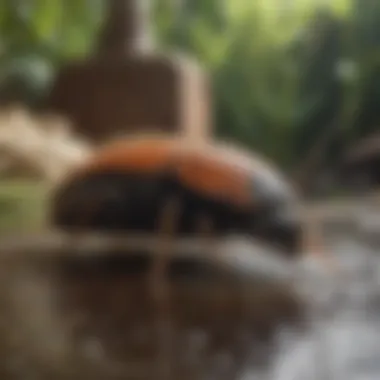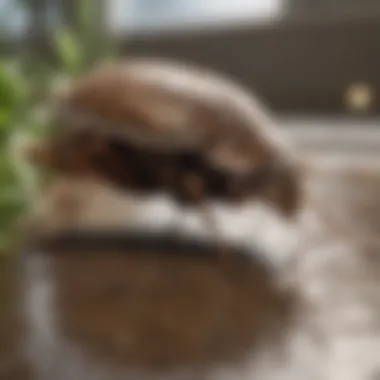The Ultimate Guide to Proactive Pest Control Measures for a Pest-Free Environment


Preventive Pest Control Strategies
When it comes to maintaining a pest-free environment, preventive pest control strategies play a crucial role in warding off unwelcome intruders. One of the fundamental aspects of preventive pest control is protecting the house exterior. This includes diligently sealing cracks that may serve as entry points for pests, clearing debris around the perimeter of the house, and implementing measures to keep pests from entering the living spaces.
Yard maintenance is another essential component of proactive pest control. Regular yard care routines such as mowing the lawn, pruning plants, and removing standing water help in creating a pest-free outdoor environment. Indoor cleanliness is equally important, with expert cleaning tips and techniques aimed at minimizing hiding spots and breeding grounds for pests.
Proper garbage disposal is a key aspect of preventing pest infestations. Efficient waste disposal methods not only keep the surroundings clean but also eliminate potential food sources for pests. Alongside these fundamental strategies, homeowners can explore innovative ways to safeguard their homes from pest invasions.
Identifying Pest Risk Areas
Identifying pest risk areas within and around the property is vital for developing targeted pest control measures. Inspecting moisture-prone areas for damp conditions and taking steps to prevent infestations in such spaces are critical in mitigating pest problems. Similarly, conducting crack and crevice inspections to identify access points for pests and sealing them off are essential steps in pest control.
Greenery inspections can reveal potential pest risks associated with landscaping features. Understanding how greenery can attract or repel pests enables homeowners to make informed decisions to maintain a pest-free yard. Additionally, addressing miscellaneous pest risk areas proactively helps in implementing comprehensive pest prevention measures.
Effective Pest Control Methods
When preventive measures fall short, effective pest control methods come into play. Natural repellents using essential oils, herbs, and plants offer safe and eco-friendly solutions for keeping pests at bay. Chemical sprays, when used judiciously, can eradicate pests efficiently, while pest traps provide effective solutions for capturing and removing pests safely.
Embracing biological control methods involves using natural predators to manage pest populations, promoting environmentally-friendly pest control practices. Beyond traditional methods, homeowners can explore other innovative pest control techniques to address specific pest challenges.
Pest Species Identification
Effective pest control begins with identifying the pest species at play. Recognizing common insects like ants, cockroaches, and spiders helps in implementing targeted control measures. Similarly, understanding rodent species such as mice and rats aids in preventing rodent infestations.
Addressing bird species impacting residential environments and dealing with wildlife encounters responsibly are part of comprehensive pest management. Additionally, identifying and managing lesser-known pests effectively contributes to a wholesome pest control approach.
DIY Pest Control Techniques
For those looking to take a hands-on approach to pest control, DIY techniques offer practical solutions. Homemade pest control remedies using eco-friendly ingredients provide an alternative to chemical-based products. Essential oils serve as natural pest repellents, creating a bug-free environment at home.
Setting up effective pest traps and barriers, relying on reputable pest control brands, and exploring miscellaneous DIY pest control techniques round up the arsenal of tools available to homeowners in managing pests effectively.
Introduction
In the realm of pest control, an active approach is paramount to maintaining a pest-free living or working environment. This section serves as the gateway to a realm where the battle against pests is not reactive but proactive, ensuring that infestations are prevented rather than merely treated. Understanding the fundamentals of active pest control is essential in comprehending the significance of early intervention and strategic measures. By delving into this segment of the guide, readers will gain a solid foundation in the principles that underpin effective pest management.


Understanding Pest Control
Defining pests and their impact
A critical aspect of navigating the realm of pest control is establishing a clear definition of what constitutes a pest and acknowledging the ramifications of their presence. Defining pests goes beyond mere identification; it involves recognizing how these unwanted intruders can disrupt ecosystems, damage property, and pose health risks. By comprehending the impact of pests, individuals and organizations can better appreciate the urgency of proactive pest control measures. The ability to define pests accurately empowers stakeholders to develop tailored strategies that address specific pest challenges head-on, leading to enhanced success rates in pest management endeavors.
The importance of proactive pest control
Proactive pest control stands as a fundamental pillar in the realm of pest management. By emphasizing prevention over reaction, proactive strategies aim to pre-empt potential infestations before they escalate into severe problems. The significance of adopting proactive pest control methods lies in their ability to save time, resources, and mitigate risks associated with pest-related damages. Investing in proactive pest control measures not only safeguards properties and inhabitants but also promotes a culture of vigilance and environmental responsibility. Recognizing the importance of proactive pest control sets the stage for a proactive and sustainable approach to pest management.
Common Pest Infestations
Types of pests commonly encountered
A detailed exploration of the types of pests that commonly infiltrate residential, commercial, or agricultural spaces is vital in understanding the breadth of challenges faced in pest control. From nuisance pests like ants and cockroaches to destructive ones such as termites and rodents, each category poses unique threats that demand specific control measures. Identifying the characteristics and behaviors of common pests equips individuals with the knowledge needed to implement targeted eradication strategies effectively. By shedding light on prevalent pests, this section serves as a roadmap for readers to navigate the nuances of pest management with precision and efficacy.
Potential risks associated with pest infestations
Understanding the risks associated with pest infestations is foundational in persuading stakeholders to prioritize pest control measures. Pest infestations can lead to property damage, contamination of food supplies, and the transmission of diseases, posing serious threats to human health and well-being. Acknowledging these risks underscores the critical need for robust pest control protocols that safeguard against potential harms. By highlighting the adverse outcomes of pest infestations, individuals are compelled to take proactive steps in mitigating risks and creating safer living environments for themselves and their communities.
Benefits of Active Pest Control:
In the realm of pest control, the significance of active pest control cannot be overstated. This section delves into the crucial role that proactive measures play in maintaining a pest-free environment. By implementing active pest control strategies, individuals can effectively combat and prevent pest infestations before they become unmanageable. From early detection methods to the implementation of preventative measures, this article explores every aspect of active pest control in great detail.
Prevention of Infestations:
Early Detection Methods:
Delving specifically into early detection methods, this subsection sheds light on the pivotal role that early intervention plays in pest control. By utilizing early detection measures such as regular inspections and monitoring systems, individuals can identify pest issues at their inception, preventing widespread infestations. The key characteristic of early detection methods lies in their ability to nip pest problems in the bud, safeguarding properties and ensuring timely remediation. Though not foolproof, early detection methods serve as a popular choice due to their efficacy in catching pest issues early, thus minimizing damage and costs associated with severe infestations.
Implementing Preventative Measures:
Transitioning to discussing preventative measures, this section underscores the importance of proactively safeguarding against pests. By implementing measures such as sealing entry points, maintaining cleanliness, and proper waste management, individuals can create an inhospitable environment for pests, deterring infestations before they occur. The unique feature of implementing preventative measures is their proactive nature, addressing potential pest vulnerabilities before they escalate into significant problems. While these measures require consistent effort and diligence, their advantages lie in long-term pest prevention and reduced reliance on reactive pest control measures.
Health and Safety:


Reducing Health Risks Associated with Pests:
Focused on reducing health risks related to pests, this subsection examines the critical aspect of safeguarding health in pest control practices. By mitigating health risks associated with pest infestations through proper sanitation, pest-proofing, and timely pest control interventions, individuals can protect themselves and their environments from potential health hazards. The key characteristic of this approach is its emphasis on preventive actions to minimize health risks posed by pests, promoting a healthier living environment. While not a one-size-fits-all solution, reducing health risks associated with pests is a valuable choice in creating safe, pest-free spaces.
Ensuring a Safe Environment:
Lastly, ensuring a safe environment further reinforces the commitment to maintaining a healthy and secure living or working space. By implementing pest control measures that prioritize safety, individuals can rest assured that their surroundings are free from potential hazards linked to pests. The key characteristic of this aspect is its dedication to creating a safe and sustainable ecosystem, free from the harmful impacts of pests. The unique feature of ensuring a safe environment is its focus on comprehensive solutions that not only eliminate pests but also promote overall safety and well-being. While requiring ongoing vigilance, the advantages of ensuring a safe environment are evident in the peace of mind and security it affords occupants in pest-prone areas.
Implementing Active Pest Control Strategies
In the holistic approach to pest management detailed in this article, Implementing Active Pest Control Strategies emerges as a cornerstone for maintaining a pest-free environment effectively. These strategies play a pivotal role in ensuring that proactive measures are in place to combat pests across various settings. By focusing on Implementing Active Pest Control Strategies, individuals and businesses can preemptively address potential pest issues before they escalate. This proactive stance not only saves time and resources but also promotes a healthier and safer living or working environment. Through a systematic implementation of these strategies, the challenges posed by pests can be mitigated effectively.
Integrated Pest Management
Utilizing sustainable pest control practices
Within the framework of Integrated Pest Management, the emphasis on Utilizing sustainable pest control practices is paramount. This approach advocates for environmentally friendly and non-toxic methods to deter and manage pest populations. The key characteristic of Utilizing sustainable pest control practices lies in its long-term effectiveness without compromising the ecosystem or human health. By favoring natural solutions over conventional chemical interventions, this strategy aligns with the overarching goal of achieving sustainable pest control.
Minimizing chemical interventions
Another significant aspect of Integrated Pest Management is Minimizing chemical interventions. This method underscores the reduction of reliance on chemical pesticides, thereby minimizing potential harm to the environment and inhabitants. The key characteristic of Minimizing chemical interventions is its targeted approach, focusing on strategic interventions where necessary while prioritizing non-chemical alternatives. This approach not only safeguards against chemical exposure but also contributes to fostering a more balanced and sustainable pest management ecosystem.
Regular Inspections
Identifying vulnerable areas
When engaging in Regular Inspections, identifying vulnerable areas is a fundamental step in proactive pest management. By pinpointing these susceptible locations, individuals can tailor their pest control strategies to address specific weak points effectively. The key characteristic of Identifying vulnerable areas is the precision it offers in detecting potential pest entry points or breeding grounds. This proactive identification enables individuals to fortify these areas and render them less hospitable to pests.
Monitoring pest activity
Complementing the process is Monitoring pest activity, which involves the consistent observation of pest behavior and population trends. By staying vigilant and tracking pest movements, individuals can gauge the efficacy of their pest control measures and adjust them if necessary. The key characteristic of Monitoring pest activity is its diagnostic nature, providing insight into the effectiveness of pest control strategies in place. This real-time feedback loop allows for timely interventions, promoting more efficient pest management practices.
Professional Pest Control Services
In the realm of active pest control, the utilization of professional pest control services stands as a crucial component. These services play a vital role in ensuring the effective management and eradication of pests within various environments. By entrusting experts in the field, individuals and establishments can benefit from specialized knowledge and advanced techniques tailored to address unique pest challenges. Professional pest control services encompass a wide range of benefits that extend beyond mere extermination. They involve comprehensive inspections, customized treatment plans, and ongoing support to maintain a pest-free environment.


Hiring Pest Control Experts
Benefits of professional services:
Delving into the specific aspects of professional pest control services, the benefits are manifold and contribute significantly to the overall goal of maintaining pest-free spaces. One key characteristic is the expertise that professionals bring to the table. Their in-depth understanding of pest behaviors enables them to formulate targeted strategies for eradication. This expertise results in more efficient and effective pest control measures, ensuring long-term solutions to infestation problems. Professionals also employ environmentally friendly alternatives, minimizing harm to both humans and the ecosystem. Their utilization of safe and approved methods makes them a popular and beneficial choice for ensuring pest control in diverse settings.
Factors to consider when choosing a pest control company:
Another pivotal aspect to ponder is the selection of a suitable pest control company. Considering factors such as reputation, experience, and the range of services offered can greatly impact the effectiveness of pest control efforts. A key characteristic to highlight is the track record of success and customer satisfaction. This demonstrates the company's reliability and competence in managing pest issues. Additionally, choosing a company that prioritizes communication and transparency can help foster a trusting relationship, leading to better outcomes. However, one must be mindful of the possible disadvantages, such as high costs or contractual obligations, when opting for professional pest control services.
Customized Pest Management Plans
Tailoring solutions to specific needs:
Customized pest management plans are essential in addressing the unique requirements of different environments. This aspect contributes significantly to the overall goal of effective pest control. One key characteristic of tailored solutions is their specificity. By customizing treatment plans according to the type of pests, severity of infestation, and structural layout, pest control experts can deliver targeted and efficient services. This personalized approach ensures that the root causes of pest problems are identified and resolved effectively, minimizing the likelihood of future infestations.
Continuous monitoring and support:
Equally important is the element of continuous monitoring and support provided by pest control services. This feature contributes to the overall goal of maintaining a pest-free environment over the long term. The key characteristic of continuous monitoring is its proactive nature. By regularly assessing pest activity and potential risks, professionals can intervene promptly to prevent escalation of infestations. Moreover, ongoing support in the form of recommendations for preventive measures and regular check-ups ensures that the space remains safeguarded against pests. However, it is essential to weigh the advantages of continuous monitoring against any associated costs or commitments to make an informed decision about opting for this service.
Sustainable Pest Control Practices
In the realm of active pest control, Sustainable Pest Control Practices emerge as a fundamental pillar. Their significance lies not just in eradicating pests but doing so in a manner that minimizes harm to the environment and promotes long-term ecological balance. Embracing sustainable practices means adopting a holistic approach that goes beyond immediate pest removal, considering the wider impact on ecosystems and biodiversity. By integrating sustainable pest control methods, we not only address current infestations effectively but also safeguard the delicate balance of nature for future generations.
Environmentally Friendly Solutions
Using Eco-Friendly Products and Methods
An integral component of Sustainable Pest Control Practices is the utilization of eco-friendly products and methods. These solutions prioritize the well-being of the environment while effectively combating pests. The key characteristic of using eco-friendly products and methods is their ability to target pests efficiently without causing harm to non-target species or polluting the ecosystem. Opting for these environmentally friendly alternatives ensures that pest control efforts align with broader sustainability goals, making them an ideal choice for environmentally conscious individuals and organizations. The unique feature of using eco-friendly products and methods lies in their efficacy in pest management without compromising environmental integrity, offering a balanced approach that benefits both the ecosystem and human health.
Promoting Biodiversity
Promoting biodiversity plays a crucial role in sustainable pest control initiatives. By fostering a diverse range of species within ecosystems, we create natural checks and balances that help regulate pest populations organically. The key characteristic of promoting biodiversity is its ability to cultivate resilient ecosystems that are less prone to pest outbreaks, reducing the reliance on chemical interventions. Embracing biodiversity not only supports healthy ecosystems but also enhances the overall effectiveness of pest control measures. The unique feature of promoting biodiversity lies in its ability to create harmonious ecological systems where pests are managed naturally, offering a sustainable solution that benefits both the environment and human well-being.
Community Involvement
Engaging the community is vital in fostering a unified front against pest infestations, making Community Involvement a cornerstone of effective pest control strategies. By educating and raising awareness among individuals, communities can build resilience and knowledge to tackle pest issues collectively. The key characteristic of education and awareness programs is their capacity to empower individuals with the information and skills needed to identify, prevent, and address pest problems effectively. These programs not only equip people with valuable knowledge but also instigate proactive measures that mitigate the risks associated with pests, contributing to healthier living environments.
Collaborative Initiatives
Collaborative initiatives bring together various stakeholders to pool resources, expertise, and efforts towards comprehensive pest management. The key characteristic of collaborative initiatives is their ability to leverage diverse perspectives and contributions to develop robust solutions that address pest challenges holistically. By fostering partnerships and collaboration, these initiatives tap into collective wisdom and resources, amplifying the impact of pest control measures. The unique feature of collaborative initiatives lies in their capacity to promote synergy among different stakeholders, encouraging shared responsibility for pest management and fostering a sense of community ownership. Through collaboration, communities can effectively tackle pest issues, creating sustainable, long-term solutions that benefit both individuals and the environment.



